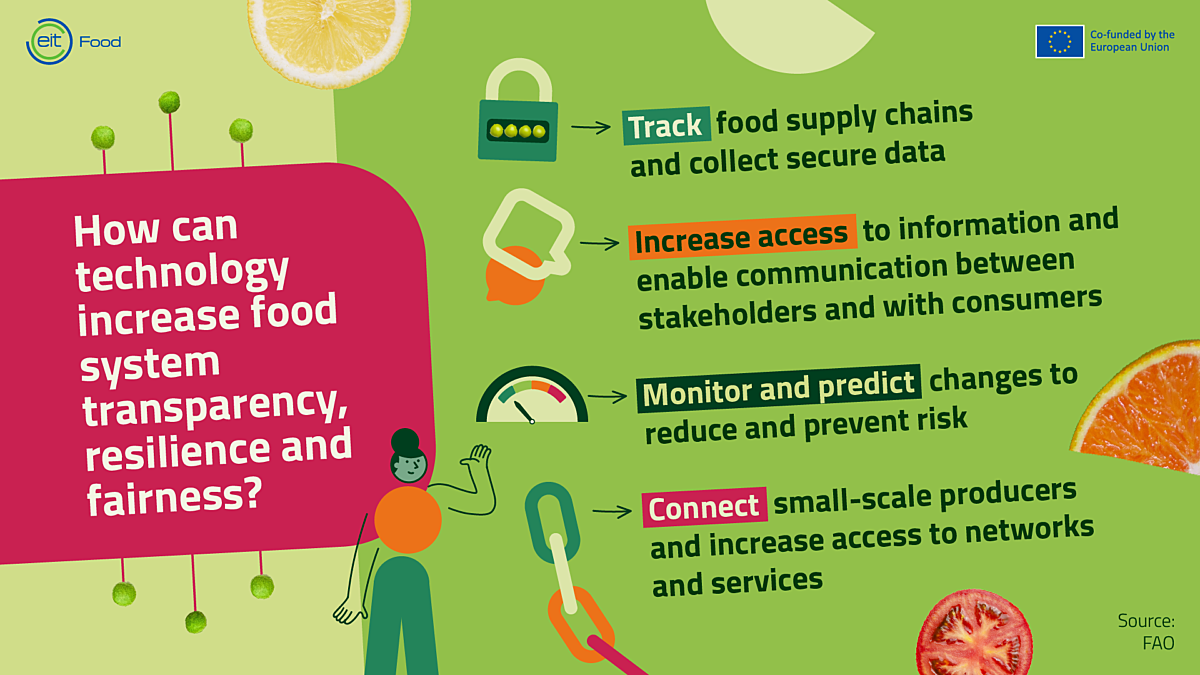
How can digital technologies increase food system transparency, resilience, and fairness?
Now more than ever we must ensure everyone can always access healthy and sustainable food, and innovative digital technologies are helping to find new solutions – here we explore some of the key examples.
As the world's human population grows and climate change impacts food security, digital technologies are becoming increasingly critical for ensuring transparency, resilience, and fairness across the food system.
However, technology and digitalisation are often expensive and can be out of reach for small-scale farms and businesses. So, how can we ensure these technologies are available to all stakeholders, and the associated food is affordable for all consumers?
Here are four ways that technology can increase food system transparency, resilience and fairness (1):
- Track food supply chains and collect secure data
- Increase access to information and enable communication between stakeholders and with consumers
- Monitor and predict changes to reduce and prevent risk
- Connect small-scale producers and increase access to networks and services.

Track food supply chains and collect secure data
To create a food system where healthy and sustainable food is available for everyone, it is imperative that processes and systems are connected across the entire food value chain, from farms and production facilities through to storage, retail, consumption, and distribution. This includes finding new ways to securely track food across the supply chain.
Startups and organisations such as Tracifier are already using and developing digital technologies such as blockchain-powered platforms to track and validate products in the food system. By implementing digital systems in this way, complex supply chain challenges such as inconsistent and unavailable data, manual labour and unmanageable levels of paperwork can be easily identified and resolved in a secure way (2).
The use of blockchain in the food system has been increasing for some time, but challenges such as energy consumption, time investment and cost have meant its uptake has been slower than expected. However, developments in the sector mean there could be more applications on the horizon. This includes the ability to ‘greenify’ blockchain systems through the utilisation of renewable energy, meaning businesses can offset their carbon emissions through the use of blockchain-powered transactions. Blockchain systems, such as the one used for Bitcoin transactions, require large levels of processing power as well as energy-intensive warehouses for storing computer racks. This leads to increased levels of energy consumption, with the University of Cambridge estimating that Bitcoin accounts for approximately 0.6% of global energy usage (3).
Machine-to-machine transactions may also play a greater role which could enable food system businesses to automate transactions using cryptocurrencies, reducing the risk of data breaches and ensuring secure traceability.
Increase access to information and enable communication between stakeholders
However, accessing these technologies in the first place can be difficult. Everyone has a role to play in increasing access to technology, and businesses and governments must work closer together to implement the right strategies, policies, and support programmes, recognising that different sized farms and businesses have different needs. By enabling open platforms, data and analytics can be used to increase access to information and enable better communication between stakeholders. Data and insights from other businesses and research programmes, for example, can be shared and accessed more widely, meaning challenges can be tackled in a way that is based on evidence and optimises results.
Climate Farmers, for example, is monitoring and collecting best practices for sustainable agriculture to create an open platform that farmers and stakeholders can use to assess the positive outcomes for soils, ecosystems, and the climate. This means stakeholders can share knowledge and then replicate methods and techniques based on local needs and capabilities.
Consumers must also be involved in this process. A study on consumer food behaviours led by Aarhus University found that over half of European consumers surveyed think the war in Ukraine has increased food prices in Europe, and 48% think costs are being unfairly distributed (4). This emphasises the importance of providing all stakeholders, including consumers, with access to transparent and easy-to-understand information to ensure fairness across the food system. By empowering consumers in this way and enabling them to hold businesses accountable based on information, consumers are rightfully considered an important food system stakeholder. Startups such as Connecting Food are helping to bridge this gap through the use of QR codes on food products whereby consumers are able to scan a product and gain access to verified information about the product’s supply chain journey.
Monitor and predict changes to reduce and prevent risk
The introduction of digital technologies such as RisingFoodStar SwissDeCode’s DNA test can also help to monitor, track and certify food products through the food supply chain in real time, enhancing the decision-making abilities of stakeholders. This can help to quickly reduce the risk of food fraud and contamination as well as food waste and loss by avoiding supply chain disruptions. This also includes providing farmers and producers with real time information about their supply chains such as environmental conditions, market prices and transport logistics to ensure produce is protected and not wasted unnecessarily.
A recent study by the European Commission on the main drivers of food security also identified that precision agricultural technologies such as sensors, robotics and data-driven support systems are considered technologies with a potential to contribute to sustainable and resilient food systems, and thus food security in the EU (5).
Connect small-scale producers and increase access to networks and services
In order to connect small-scale producers, the FAO suggests that technology itself could be the answer. By narrowing the ‘digital divide’ and increasing access to mass technologies such as the internet and mobile networks, small-scale farms and remote businesses, for example, can use mobile applications and devices to better access supply chain information, inputs, markets, and finance (1). They can also be used to educate stakeholders about the latest technological developments in the food system (1), meaning solutions and techniques can be adapted to meet local needs.
Platforms such as Agri Marketplace are offering end-to-end solutions for farmers and food producers, specialising in using blockchain to create more efficiency and transparency along different channels of the agrifood sector. By matching supply and demand over specific agricultural markets, farmers and producers can access markets faster and more transparently from anywhere in the world. This can in turn embed resilience by empowering farmers to plan ahead with credible and easy to access information. The platform also acts as a digital tool for agricultural businesses with services such as secure payments, legal support, and traceability in transactions.
Accelerating the development and uptake of technology in the food system
Transparency, resilience, and fairness in the food system can only be achieved by greater collaboration and knowledge sharing. By pooling resources and working together, access to technology can become the norm for every stakeholder. To learn more about technology in the food system and its role in shaping the future of food, why not take this online course from FutureLearn?
You can also stay on top of the latest technological trends by signing up to The Feed newsletter and joining the EIT Food community.
References
- FAO: Five ways science, technology and innovation are helping to transform the world’s agrifood systems
- FAO: Emerging opportunities for the application of blockchain in the agri-food Industry
- University of Cambridge: Cambridge Bitcoin Electricity Consumption Index
- EIT Food: European consumers cut back on food costs to cope with shortages and rising prices
- European Commission: Analysis of main drivers on food security
More blog posts

AgristarBio: Producing the unique Fertilizer







